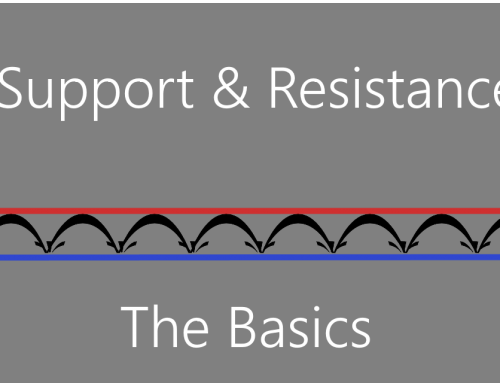Many of the best stock trades come from playing “the bounce.” When it comes to balancing risk and reward, we’ve found that entering a stock bounce trade near a support level can be a great way to go. No tactic will always work perfectly, but stock bounce plays give us a low risk entry and a clearly defined point at which to set Stops. Below are some tips that can help traders to navigate this stock trade and increase the probability of success.
Take a look at daily charts for a number of stocks, and you’ll notice that some show steady, trending price movement. Minus any news events, these stocks normally cycle up and down as buying momentum builds and fades. On many stocks the cycles occur between support and resistance levels. These “predictable” looking stocks are the most appropriate for playing the bounce.
Support and Resistance
In order to understand how to play stock bounces, we need to quickly review support and resistance. The book “Trading For A Living” by Alex Elder gives a simple, but effective image of support and resistance – “A ball hits the floor and bounces. It drops after it hits the ceiling. Support and resistance are like a floor and a ceiling, with prices sandwiched between them.”
When a stock’s price has fallen to a level where demand at that price increases and buyers begin to buy, this creates a “floor” or support level. When a stock price rises to a level where demand decreases and owners begin to sell to lock in their profits, this creates the “ceiling” or resistance level.
Why? Because investors and traders are people and they have memories! Those that follow a particular stock just “know” that it rarely falls below xx” or rises above yy”. The “floor” and the “ceiling” are not fixed barriers you can touch. They are psychological barriers built by stock traders.
How To Recognize Support and Resistance
You can identify support and resistance levels by studying a stock chart. Look for a series of low points where a stock falls to this level, but then doesn’t fall any further. This is a support level. When you find that a stock rises to a certain high, but no higher, you have found a resistance level. We like to use the 22, 50 and 200 Day Moving Averages (DMA) because they often provide reliable support or resistance levels for stocks. (Note that we use exponential DMAs for the 22 and 50 DMAs, a simple DMA for the 200.)
Take a look at a daily stock chart of HCBK (Hudson City Bancorp).

Notice the effect of support at the 22 DMA (red line) going all the way back into November 2001. Note that the chart looks a little like a ball bouncing up the upward trending 22 DMA. That’s why we call this tactic, “playing the bounce.”
Note that moving averages are not the only places to find support and resistance. Horizontal lines and trend lines also provide support and resistance. The best way to measure the strength of support or resistance is to look and see which method appears most obvious. The most obvious levels of support and resistance are the most significant.
When a stock’s movement trades within certain dollar amounts we have horizontal support and resistance. When we talk about stocks trading in a range, you can normally see these horizontal lines that seem to bind the stock between support below and resistance above. Once a stock breaks above major resistance, the resistance level can often become a support level. Once a stock breaks below a major support level, the former support level becomes the new resistance level.
Playing the Bounce
Our goal is to buy (go long) as the stock bounces upward off support. Conversely, we can sell short on a bounce down (reversal) from resistance. Sounds simple enough when we are comfortably looking in the rearview mirror, but it can be quite a bit more challenging to pull the trigger on an actual trade.
When is a Stock Bounce Really a Bounce & When is it Just a Head Fake?
Actually, you never really know until after the fact. That’s why we use stops as part of our Risk Control strategy. We don’t have a crystal ball, but we do have tactics that allow us to trade successfully. One of the most important tactics is to use “stops.” When you buy a reasonable number of shares of a stock at a critical turning point and set your stop a reasonable distance below your entry, then the amount you risk is reasonable.
Using The RightLine Report To Play The Stock Bounce
In almost every issue of the Report you will find stocks with bounce play instructions similar to this: “If the stock weakens, plan to enter long on a bounce upward near 50-DMA support at 31.” Let’s assume that you are interested in this trade. What should you do?
Start by opening up a daily chart of the stock to locate the support level. As you look at the chart, use the stock write-up in the Report to determine exactly what is providing support at this time. We typically include this information – usually a key Daily Moving Average like the 22, 50 or 200 DMA, a trend line, or a specific horizontal price level. Once you are comfortable that you understand the type and location of the specific support, you will want to monitor the price action, preferably by setting an alert to let you know when the stock price drops to near the support level. Once the price action gets within this “hot” zone, things begin to get interesting.
Bounce entries are more subjective than many other types of plays. Each trader has to make the call as to whether a bounce is indeed underway, and when to enter. The specific price point where you enter the bounce is determined in large part by the time frame you prefer and your tolerance for risk. Using our daily chart example from above, there are several good ways to set your specific entry point. First understand that every trade you enter should have two key ingredients – a setup and a trigger. This principle applies not only to bounce trades, but to every trade that you enter. The setup in our example is obvious – a potential bounce from support. Choosing the trigger requires that we set an entry based on price action that confirms a bounce is underway. This is where knowing our time frame and tolerance for risk comes in.
You’ll find “bounce” trading setups in all time frames.
Very short term, aggressive buyers trading five minute bar charts will often jump into a stock on a very small uptick of a few cents, while more conservative daily or weekly chart traders prefer to wait until they are certain that a bounce is underway. Though the two approaches may seem to be in conflict, they really aren’t. A shorter-term trader needs to set a quick trigger because the profit target in points is smaller and will be reached within a matter of minutes or a few hours. On the other hand, a longer-term trader will set a higher trigger, raising the odds that the bounce will continue over a longer period – perhaps several days or even longer.
There are numerous ways to decide on the best trigger for your trade. When using charts to determine your entry point, always take a look at the previous bar action. The open, close, high and low of the prior bar each present a trigger level that can be used to confirm that a bounce is underway and can be safely entered. For example, if you are trading daily charts and a bounce occurs at 31 as planned, a price move a quarter point above the previous day’s high might be the trigger a conservative trader prefers, while a more aggressive trader might use the previous days low as a trigger. In these instances there is no right or wrong – one is just more aggressive than the other. In every case, always use initial stops to protect against losses, and then apply trailing stops to lock in profits as the trade moves favorably.
Just because a stock drops to the support level, hesitates and then temporarily falls below support doesn’t mean the bounce entry is no longer valid. Bounces don’t always occur exactly at the support level. If a stock drops below the support level, keep an eye on it. Stocks will often dip below support, only to rebound back above the support level and give traders a nice entry. Again, refer to the chart for prior bar(s) action to set your entry point (trigger).
Getting back to our example “to enter long on a bounce upward near 50- DMA support at 31.” Let’s say the stock drops as expected, but doesn’t make it all the way down to 31. Instead, it only falls to 32, then begins to move higher. Volume looks strong, and you are convinced it is a “real” bounce. What do you do? It’s okay to enter as long as you have set a trigger based on reasonable criteria, such as previous bar action. Just remember to set a stop.
Once in the position, you may see the stock move quickly higher. If it does, move up your stops to protect a portion of your profits and continue trailing the stops as it moves higher. The longer you expect to hold a stock, the looser you should set your stop so you won’t get stopped out too quickly. A stop amount between one and a half to three times the 14-bar Average True Range (ATR) will often work quite well.
“Anticipating Stock Bounce Plays Near Moving Averages”
We often suggest that readers watch for a potential “bounce near” entry into a stock based on an anticipated bounce off a moving average. If a stock is trending up, the support may be at a different price by the time you trade the stock than it was when we set the expected bounce level. You can still play the bounce, even if it isn’t bouncing off the exact same price level that we mentioned in the report. Always be sure that you understand the reason for the expected bounce, and check the chart to see if the support level has changed.
RightLine Tracking Criteria for “Bounce Near” Setups and Triggers
To determine what constitutes “near” when tracking plays that anticipate bounces from Moving Averages – we use a defined “bounce zone” (‘reversal zone’ for shorts). The mid-point of the zone is the specified Moving Average. The zone extends away from the mid-point in both directions by a set amount.
Use the amounts below to set the “bounce near” zone boundaries.
Use 0.11 for stocks priced up to $10, 0.16 for stocks from $10.01 to $20, 0.26 for stocks from $20.01 to $50.01, 0.51 for stocks from $51.01 to $100, 1.01 for stocks over $100
Long Example: If the Moving Average (mid-point) for a bounce is at $20, then the zone boundaries are placed 0.16 above and 0.16 below the mid-point (Upper boundary: 20.16 / Lower boundary: 19.84). If price penetrates the zone, then reverses and moves beyond the upper boundary by 0.16, the entry is triggered.
Setup Criteria: The “bounce near” Setup is considered complete when the price action penetrates the “bounce zone.”
Trigger Criteria: The entry is Triggered when price reverses and moves beyond the zone boundary by the specified amount (ex: 0.16 for a $20 stock).
Good Until: The setup is good for up to 2 weeks.
Void Setup: The setup is void if price enters the zone and then exits thru the other side of the zone within the 2-week limit. The setup is also void is price enters the bounce zone but doesn’t reverse enough to reach the trigger within the 2-week limit.
The Difference Between a “Bounce Near Play” and a “Bullish Bounce Play”
There is a major difference between a “Bounce Near” setup and a “Bullish Bounce” setup. When you read about a Bullish Bounce setup in the RightLine Report, the Setup has already occurred and the entry Trigger has been determined – though not yet reached. On the other hand, a “bounce near” trade simply anticipates a potential bounce setup – neither the setup nor the trigger have yet been reached. In a “bounce near” play, it is up to the reader to anticipate the setup, define it when it occurs, and establish a Trigger for entering.
Remember:
*In this article we focused primarily on buying stocks on bounces off support. However, we often recommend shorting stocks as they bounce downward – reverse – from resistance. The concepts are the same, but instead of looking at it like a ball bouncing up off the floor, it is more like a ball bouncing down off the ceiling.
* When it appears that a stock has “over-reacted” to a news event it can be good time to look for a bounce, especially if the stock is approaching a key support level. But remember, if you get your entry, set your stop and trail it higher to avoid getting stung.
*Anticipating stock bounces near moving averages requires a bit more thought than just entering trades using specific RightLine entry points, but it can be an excellent way to pick up quick profits on lower risk stock trades.






